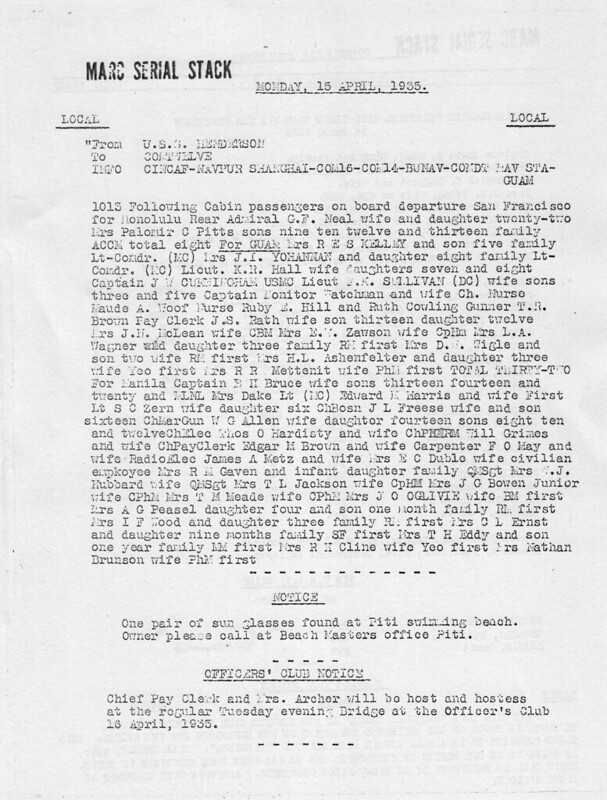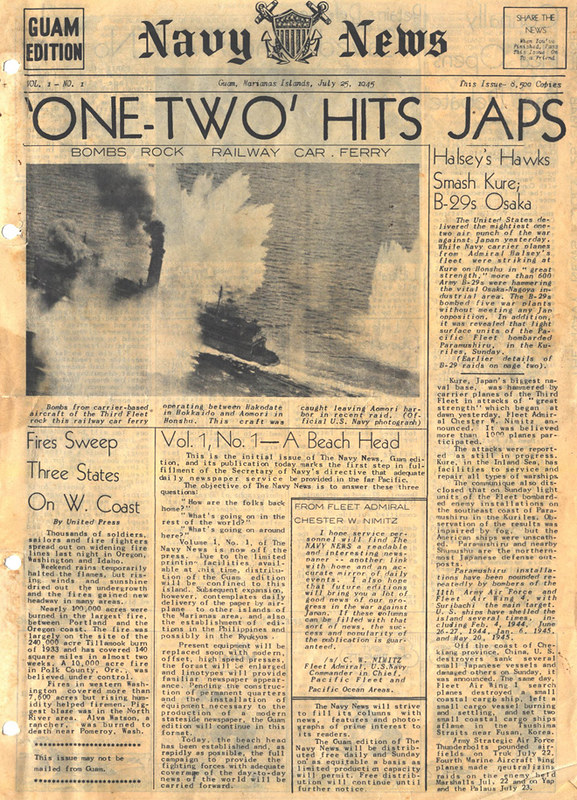Early Guam newspapers
Two publications that emerged during the US Naval Administration of Guam (1898-1941) were the Guam Eagle and the Guam Echo. The Guam Eagle replaced the Guam Recorder as the main printed source of news, information and local interest stories about the island. The Guam Eagle was owned and operated by the United States Navy prior to World War II.
The Guam Echo was a publication by a Washington-based interest group called the Institute of Ethnic Affairs. The Guam Echo started up shortly after World War II in response to continued US Navy control of the island and called for self-determination for the people of Guam.
Guam Eagle
The Guam Eagle, operated by the US Navy, was a daily newspaper published in the 1930s and available to all of Guam’s readership. The newspaper supposedly got its name in reference to the ubiquitous large, flying cockroaches on the island, nicknamed “Guam Eagles.” The newspaper began printing around the same time the first commercial radio station, K6LF, started broadcasting on Guam.
Prior to the Guam Eagle, the Guam Recorder had been the main publication for current print information about the island and its people. The Guam Recorder was a monthly magazine privately owned by a former Yosemite sailor and blacksmith named William W. Rowley. The Guam Recorder, which began publishing in March 1924, replaced the Guam News Letter, the first monthly newspaper on the island. The Guam News Letter had been published by the US Navy, and initially was printed in both English and Spanish for economic reasons.
However, the Guam News Letter ceased publication in 1922 and was replaced by the Guam Recorder. Similarly, because of the nationwide economic downturn of the Great Depression, the Guam Recorder was unable to print, and eventually was bought out by the US Navy in 1933. The magazine continued to print stories of local interest, including island history, recipes and local folklore.
Around this time, the Guam Eagle made its appearance as the first daily newspaper. Initially in mimeographed format, the Navy edited and distributed the paper, but like the Guam Recorder, would stop printing by World War II with the invasion of the island by Japanese forces.
Even with the outbreak of war on Guam, however, navy radioman George Tweed managed to keep the newspaper going for four months with a patched radio and a loaned generator. Tweed compiled and typed the news of the war from broadcasts from KGEI in San Francisco into the Guam Eagle, and made five copies to circulate among the CHamorus/Chamorros. One CHamoru who helped circulate the Guam Eagle was Ben Pangelinan. Pangelinan was showing the newspaper to other people at the home of Joaquin Limtiaco in Hagåtña. The Limtiaco residence was raided by Japanese military, but Pangelinan escaped capture by flushing the newspaper down the toilet.
As the Japanese intensified their efforts to find Tweed and other escaped American military personnel—and to punish those who helped them—Tweed could no longer print the Guam Eagle. Nevertheless, the CHamorus found other ways to find and distribute news of the war through hidden radios and messages passed by hand.
After World War II, the Guam edition of the Navy News, a military newspaper, started publishing in 1945. By 1946, the Catholic Church began printing their weekly newspaper, the Umatuna si Yu’us (today known as the Pacific Voice) for local parishes. The Navy News eventually was renamed the Guam News in 1947, and in 1950, the publication was sold to local businessman Joseph Flores. The newspaper was renamed the Guam Daily News, with the Sunday edition called the Territorial Sun. The Guam Daily News was the forebear of today’s Pacific Daily News, a Gannett newspaper.
Guam Echo
With the end of World War II and the return of US naval administration of Guam came renewed efforts to address issues of US citizenship, civil rights and governance for the CHamoru people of Guam, now referred to as Guamanians. A political divide emerged, with one side comprised of Guamanians who supported navy policies, and another comprised of those who did not.
Prominent CHamoru men led by Francisco B. Leon Guerrero, including BJ Bordallo, Jose Manibusan and Father Oscar Calvo, who had led the struggle for CHamoru civil rights before World War II, continued the fight for citizenship after the war. They opposed military restrictions and other apparent violations of rights of the CHamoru people. CHamorus who supported the naval administration included families that had invested in the Guam Commercial Corporation under the leadership of Antonio B. Won Pat, with the belief that the road to citizenship began with economic self-sufficiency.
Throughout the late 1940s, in the interplay between the US Navy, the US Congress and the White House, efforts to provide Guam with a civilian government and civil rights received greater support largely because of growing public awareness of Guam—considered a faraway American territory in the western Pacific. Despite arguments that naval rule on Guam was benevolent and the island’s strategic position was necessary for national defense, others in Washington believed that Guam should be released from naval rule and become self-governing.
Historian Robert Rogers has asserted that anthropologist Laura Thompson’s ethnography Guam and Its People in particular shed light on the situation of Guam. In the third edition of her book, Thompson was especially critical of naval rule and its impact on the culture of the CHamoru people. Another source that expressed opposition to the naval government was the Guam Echo, a monthly publication by the Institute of Ethnic Affairs in Washington, DC, whose president was John Collier—Laura Thompson’s husband. Collier was a former commissioner of Indian Affairs in the Department of Interior and was highly sympathetic to the issues that affected indigenous peoples.
The first issue of the Guam Echo was printed in February 1947 and publication continued through 1950 with a total of 37 issues. Edited by Doloris Coulter (except for the last three issues), the Guam Echo was a mimeographed newsletter supported by subscriptions from Guamanians and other interested stateside residents. Its masthead stated, “Temporarily published by the Institute of Ethnic Affairs at the request of members on Guam.”
The Guam Echo provided information about activities in the US federal government leading towards self government on Guam, and was intended to stir up support for CHamoru civil rights and the end of naval rule. In fact, Coulter, along with Collier and Thompson, bombarded national journals and newspapers with letters and articles critical of US military rule in Guam, the Trust Territory of the Pacific Islands (TTPI) and American Samoa. Additionally, Thompson and the Institute of Ethnic Affairs actively lobbied and appeared before congressional committees in support of reform bills for Guam.
The Guam Echo was published partly in response to the Navy’s publication of the Navy News. Collier and Thompson had criticized the lack of news sources for the people of Guam, stating:
No newspaper is published for the 23,000 natives; no magazines come regularly, even from the States. There exists no publication in which the people can express themselves. The Navy News is published daily for 30,000 American men and officers stationed on Guam and is frequently read by the natives. But naturally, this paper is geared to the taste of Navy men. World news of interest to islanders is frequently left out…
Coulter, assigned to work on the newsletter, had to work with cost constraints and limited space. The publication, therefore, was printed in a four-page, two column, letter-size mimeographed form and would “cover Washington developments affecting Guam, news from Guam itself and news from the United Nations in New York, editorial comments and letters to the editor.” It was also noted that, “Islanders themselves had selected the name.”
Institute members who paid an annual fee of $5 would receive the publication, including CHamorus on Guam, as well as select members of Congress, White House friends and other associates in the federal government, but not the Navy Department who found other ways of obtaining issues. The first issue was full of news about the territories, as well as lists of congressmen, so that readers could write and tell them what they thought about civilian government for Guam. As Coulter expressed on page 4 of the February 1947 issue:
This first issue of Guam Echo is our answer to Guamanians’ call for news. It is an expression of freedom of the press as Americans know that freedom. It is partial fulfillment of every individual’s right to know…It should reach every family and be read by all. For only then will Guamanians keep abreast of what is happening in the world and understand the part they have to play in history. This is your newspaper. It was named by you…Do your part now to let it echo your hopes, your grievances, your news and your views. Help it speak for Guamanians.
According to Rogers, when the debate in Washington got heated over civilian government for Guam, Guam naval Governor Charles A. Pownall sought to quell opposition to naval rule and specifically targeted supporters of the Guam Echo. He ordered security investigations and special Office of Naval Intelligence (ONI) surveillance of FB Leon Guerrero and his supporters.
Allegations that Leon Guerrero was a “communist subversive” were released, but quickly rebuffed and ignored by the people of Guam. Pownall eventually sealed the fate of the naval government through his continued disregard of calls for civil rights on Guam and injustices against the CHamoru people, which culminated in the 1949 Guam Congress Walkout, and eventually, the signing of the Organic Act of 1950 for Guam.
e-Publications
The Guam Echo
The Guam Eagle
For further reading
Cogan, Doloris Coulter. We Fought the Navy and Won: Guam’s Quest for Democracy. Honolulu: University of Hawai’i Press, 2008.
Rogers, Robert. Destiny’s Landfall: A History of Guam. Honolulu: University of Hawai’i Press, 1995.




























